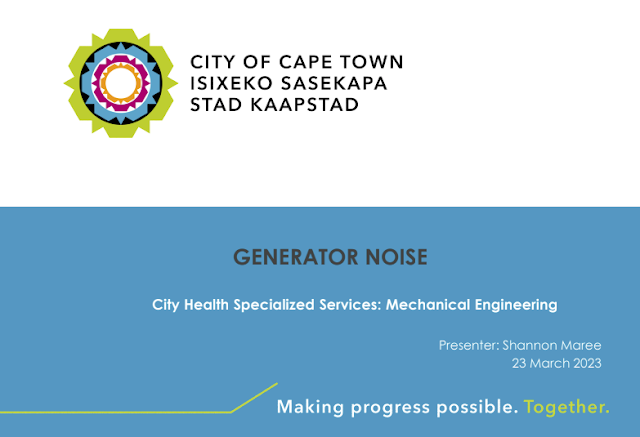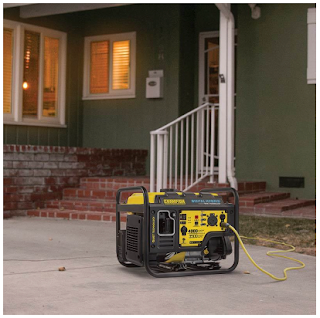LEGISLATION
Western Cape Noise Control Regulations PN200/2013Western Cape Noise Control Regulations PN200/2013
Regulation 2
Prohibition of disturbing noise
A person may not
(a) cause a disturbing noise; or
(b) allow a disturbing noise to be caused by any person, animal, machine, device,
apparatus, vehicle, vessel or model aircraft, or any combination thereof.
(a) cause a disturbing noise; or
(b) allow a disturbing noise to be caused by any person, animal, machine, device,
apparatus, vehicle, vessel or model aircraft, or any combination thereof.
Regulation 5
Noise from machinery in residential areas
A person may not use a pool pump, irrigation pump, refrigeration unit, or any heating,
ventilation or air conditioning equipment, or any similar device, in a residential area if the
noise on the property projection plane exceeds 50 dBA or exceeds the residual noise level by
more than 5 dBA, except if authorised by the local authority or in an emergency.
ventilation or air conditioning equipment, or any similar device, in a residential area if the
noise on the property projection plane exceeds 50 dBA or exceeds the residual noise level by
more than 5 dBA, except if authorised by the local authority or in an emergency.
Regulation 3
Finally, any noise source can also be assessed in terms of whether it may be a valid noise
nuisance.
nuisance.
GENERATOR NOISE:
• standby generators are a large contributor to noise pollution, especially in
densely populated areas.
• generator engines create noise from both their mechanical and combustion
forces These sounds range from 100 121 dB depending on the size of the
engine Cooling fans are also a big source of noise pollution They produce
noise by moving air at high speeds as it passes through the engine and
radiator Cooling fans produce noise at levels varying from 100 105 dB at a
distance of one meter Alternators cause noise from the friction of the cooling
air and the brushes oscillating between 80 90 dBA Inductive noise is caused
by fluctuations in the current of the winding of the alternator that causes a
mechanical noise that varies between 80 90 dB at a meter Without an
exhaust muffler, engine exhaust noise ranges from 120 130 dBA or more, but
can be reduced by at least 15 dBA with a standard muffler Mechanical
vibrations of the different parts and structural components will also add to the
radiating sounds.
densely populated areas.
• generator engines create noise from both their mechanical and combustion
forces These sounds range from 100 121 dB depending on the size of the
engine Cooling fans are also a big source of noise pollution They produce
noise by moving air at high speeds as it passes through the engine and
radiator Cooling fans produce noise at levels varying from 100 105 dB at a
distance of one meter Alternators cause noise from the friction of the cooling
air and the brushes oscillating between 80 90 dBA Inductive noise is caused
by fluctuations in the current of the winding of the alternator that causes a
mechanical noise that varies between 80 90 dB at a meter Without an
exhaust muffler, engine exhaust noise ranges from 120 130 dBA or more, but
can be reduced by at least 15 dBA with a standard muffler Mechanical
vibrations of the different parts and structural components will also add to the
radiating sounds.
Quieter options
• Generators with a spin speed of 1500 rpm are quieter than those with a 3000 rpm spin
speed. (Diesel/petrol)
• Water cooled engines are quieter than air cooled gens.
• Newer technology generators are quieter and more fuel efficient. Newer generators also
focus more on smooth running engines and vibration reduction. Inverter type generators
are an example.
speed. (Diesel/petrol)
• Water cooled engines are quieter than air cooled gens.
• Newer technology generators are quieter and more fuel efficient. Newer generators also
focus more on smooth running engines and vibration reduction. Inverter type generators
are an example.
Vibrations
Dampers, rubber, and spring mounts are all different types of anti vibration mounts
These devices basically insert rubber or springs underneath your equipment to absorb
the vibration waves and not transfer them to the harder concrete base Dampers can be
made out of neoprene or rubber and can be made as thick or as thin as needed in order
to dampen the specific amount of vibration created by your machine.
Acoustic Barriers or Insulation
Adding an acoustic barrier or insulation to the area around your generator can reduce
sound levels by up to 10 dB Acoustic barriers include concrete walls and generator
canopies You can also install sound absorbing materials like acoustic wall tiles or panels
Of course with any enclosure there is a risk of fumes and exhaust building up and
causing health concerns for any humans or animals in the immediate area.
Sound Attenuation Housing
Sound attenuation housings are large enclosures built of steel. They use
perforated sheet metal with high density rock called splitter inside. The
perforated sheet metal enables large amounts of air to pass through it while
absorbing the sound and reducing the sound wavelengths. Attenuators are
built depending on the size of your generator and your particular sound
attenuation needs.
Mufflers and Silencers
• Most generators are equipped with an exhaust muffler There are two main
types of mufflers including chamber type and spiral type Chamber type
mufflers are more effective while spiral type mufflers are more compact
• There are three types of silencers including reactive, absorptive, and
combination Reactive silencers use three chambers to help trap noise and
work best for low to mid range sounds Absorptive silencers use fiberglass
insulation to absorb high frequency sounds Combination silencers combine
designs of reactive and absorptive silencers to muffle a wide range of sounds
The only downfall to silencers is that they can possibly restrict airflow to some
degree and can impact performance Silencers are broken down into eight
categories of noise dampening.
types of mufflers including chamber type and spiral type Chamber type
mufflers are more effective while spiral type mufflers are more compact
• There are three types of silencers including reactive, absorptive, and
combination Reactive silencers use three chambers to help trap noise and
work best for low to mid range sounds Absorptive silencers use fiberglass
insulation to absorb high frequency sounds Combination silencers combine
designs of reactive and absorptive silencers to muffle a wide range of sounds
The only downfall to silencers is that they can possibly restrict airflow to some
degree and can impact performance Silencers are broken down into eight
categories of noise dampening.
Sound proofing mufflers
• Various options available
• Some more costly than others
• Have to provide a user with a reasonable time to rectify the transgression
Insulation, baffles and anti-vibration devices
Increase the Distance
Moving your generator farther from areas populated by people seems like a
no brainer to help reduce noise Doubling the distance between you and your
generator can lead to a reduction in noise by about 6 dB Moving the
generator farther away allows the wavelengths to disperse at a greater
distance, which decreases acoustic intensity, reducing the noise significantly.
Bugdet
Before purchasing a generator, consider the pollution factor and budget for
noise abatement as well as fume elimination. This could well be a significant
portion of your total expense.
DOWNLOAD the CCT Generator Noise document









